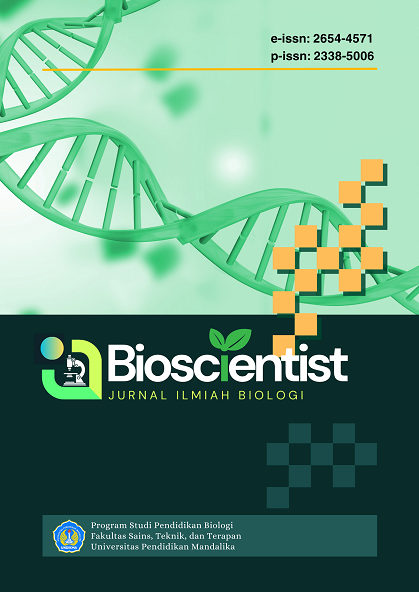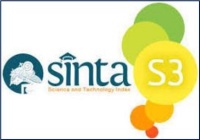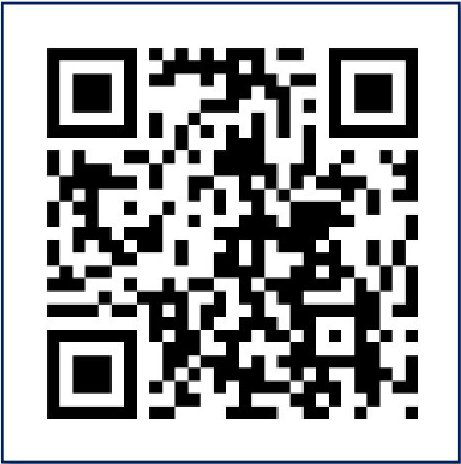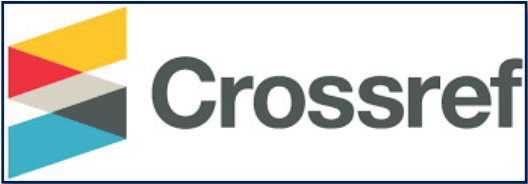Efektivitas Antidiabetes Ekstrak Bribil (Galinsoga parviflora) pada Tikus (Rattus norvegicus) Model Diabetes Melitus Tipe 2
DOI:
https://doi.org/10.33394/bioscientist.v13i3.15219Keywords:
Bribil (Galinsoga parviflora), diabetes melitus tipe 2, GDP, profil lipidAbstract
This study aims to examine the effectiveness of G. parviflora extract in reducing fasting blood glucose (FBS) levels and improving lipid profiles. The research design used was a laboratory experiment with a Completely Randomized Design (CRD). This study was conducted from June 2024 to January 2025 in the Laboratory of Biology Study Program and Integrated Mathematics and Natural Sciences Laboratory. Rats were divided into five groups, namely negative control, positive control (glibenclamide 5 mg/kgBB), and three treatment groups of bribil extract with doses of 400 mg/kgBB, 600 mg/kgBB, and 800 mg/kgBB. Parameters measured included GDP levels and lipid profiles (total cholesterol, triglyceride, HDL, and LDL levels). Data analysis was performed using one-way ANOVA test and Tukey's Post Hoc further test. The results showed that the ethanol extract of bribil (Galinsoga parviflora) doses of 600 and 800 mg/kgBB effectively reduced GDP levels, total cholesterol levels, triglyceride levels, LDL levels, and HDL levels of rats (Rattus norvegicus) T2DM model. These results indicate that bribil extract has potential as a therapeutic agent for T2DM. These findings suggested the possibility of Galinsoga parviflora extract as a DMT2 therapeutic agent.
References
American Diabetes Association. (2020). Classification and diagnosis of diabetes: Standards of medical care in diabetes. Diabetes Care, 40(Suppl 1), S11–S24. https://doi.org/10.2337/dc20-S002
Ayu, L. R., & Permana, Y. (2021). Uji aktivitas antioksidan ekstrak etanol daun jambu biji (Psidium guajava L.). Jurnal Farmasi Galenika, 7(2), 133–140.
Calabrese, E. J., & Calabrese, V. (2023). Rhodiola rosea and salidroside commonly induce hormesis, with particular focus on longevity and neuroprotection. Chemico-Biological Interactions, 380, 110540. https://doi.org/10.1016/j.cbi.2023.110540
Dewi, A. C., Widyastuti, N., & Probosari, E. (2020). Pengaruh pemberian tepung sor-gum (Sorghum bicolor L. Moench) terhadap kadar glukosa darah puasa tikus diabetes. Journal of Nutrition College, 9(1), 63–70. https://doi.org/10.14710/jnc.v9i1.26155
Dhakad, G. G., Mohale, D. S., & Chandewar, A. V. (2024). Evaluation of anti-diabetic activity of Galinosa parviflora in diabetic rats. Research Journal of Pharmacolo-gy and Pharmacodynamics, 16(3), 143–152.
Ferheen, S., Aziz-Ur-Rehman, Afza, N., Malik, A., Iqbal, L., Rasool, M. A., & Tareen, R. B. (2009). Galinsosides A and B, bioactive flavanone glucosides from Ga-linsoga parviflora. Journal of Enzyme Inhibition and Medicinal Chemistry, 24(5), 1128–1132. https://doi.org/10.1080/14756360802630433
Fitria, R., & Hidayat, M. (2018). Potensi tanaman obat dalam pengobatan tradisional antidiabetes. Jurnal Tumbuhan Obat Indonesia, 9(3), 177–185.
Handayani, I., & Mariani, D. (2019). Pengaruh ekstrak kulit manggis terhadap kadar gula darah tikus putih diabetes. Jurnal Penelitian Sains, 22(1), 21–28.
Herawati, D., & Putra, R. R. (2022). Tumbuhan lalapan masyarakat Sunda. Jakarta: BRIN Press.
Maulidya, A. A., & Pratiwi, R. (2023). Aktivitas hipoglikemik kombinasi ekstrak bro-towali dan sambiloto pada tikus diabetes. Jurnal Ilmu Kefarmasian, 10(1), 101–108.
Panche, A. N., Diwan, A. D., & Chandra, S. R. (2016). Flavonoids: An overview. Journal of Nutritional Science, 5, e47. https://doi.org/10.1017/jns.2016.41
Perkumpulan Endokrinologi Indonesia (PERKENI). (2021). Pedoman pengelolaan dan pencegahan diabetes melitus tipe 2 dewasa 2021. Jakarta: PERKENI.
Ranjitha, S., & Suganthi, A. (2017). Preliminary phytochemical analysis of Galinsoga parviflora (Cav) leaves and flowers. Journal of Research in Pharmacy, 2(3), 18–20.
Ripanda, A., Luanda, A., Sule, K. S., Mtabazi, G. S., & Makangara, J. J. (2023). Ga-linsoga parviflora (Cav.): A comprehensive review on ethnomedicinal, phyto-chemical and pharmacological studies. Heliyon, 9(2), e13103. https://doi.org/10.1016/j.heliyon.2023.e13103
Sa’adah, N. N., Kristanti, I. P., Awik, P. D. N., & Nova, M. A. (2017). Analysis of lipid profile and atherogenic index in hyperlipidemic rat (Rattus norvegicus Berken-hout, 1769) that given the methanolic extract of parijoto (Medinilla speciosa). AIP Conference Proceedings, 1–9.
Shahab, A. (2010). Komplikasi kronik DM penyakit jantung koroner. Dalam Buku ajar ilmu penyakit dalam (Jilid 3). Jakarta: Interna Publishing.
Sida, N. A., Kasmawati, H., & Idrus, L. S. (2023). Potensi bandotan (Ageratum co-nyzoides Linn.) sebagai pencegah diabetes melitus dan komplikasi terkait platelet: Pendekatan in vivo. Lansau: Jurnal Ilmu Kefarmasian, 1(2), 89–100.
Subiyono, S., Martsiningsih, M. A., & Gabrela, D. (2016). Gambaran kadar glukosa darah metode GOD-PAP (Glucose Oxsidase-Peroxidase Aminoantypirin) sam-pel serum dan plasma EDTA. Jurnal Teknologi Laboratorium, 5(1), 45–48.
Sumayyah, S., & Salsabila, N. (2017). Obat tradisional: Antara khasiat dan efek sampingnya. Majalah Farmasetika, 2(5), 1–4.
Utami, P. R., & Ramadhani, R. (2020). Uji daya hambat ekstrak daun salam (Syzygi-um polyanthum Wight Walp) terhadap pertumbuhan bakteri Escherichia coli. Jurnal Ilmiah Panmed, 15(2), 255–259.
World Health Organization. (2022). Classification of diabetes mellitus (2nd ed.). Ge-neva: WHO.
Wolfensohn, S. (2013). Handbook of laboratory animal management and welfare (3rd ed.). Oxford: Blackwell Publishing.
Yulinta, N. M. R., Gelgel, K. T. P., & Kardena, I. M. (2013). Efek toksisitas ekstrak daun sirih merah terhadap gambaran mikroskopis ginjal tikus putih diabetik yang diinduksi aloksan. Buletin Veteriner Udayana, 5(2), 114–121.
Wirawan, H., & Sulastri, D. (2020). Uji toksisitas subkronis ekstrak daun kelor (Moringa oleifera) pada tikus. Jurnal Fitofarmaka Indonesia, 7(1), 55–60.
Wahyuni, R., & Sari, A. R. (2020). Aktivitas antihiperglikemik ekstrak air daun bi-nahong (Anredera cordifolia) pada mencit. Jurnal Farmasi dan Ilmu Kefarma-sian Indonesia, 7(2), 89–95.
Downloads
Published
How to Cite
Issue
Section
License
Copyright (c) 2025 Monicha Desry Samosir

This work is licensed under a Creative Commons Attribution-ShareAlike 4.0 International License.













